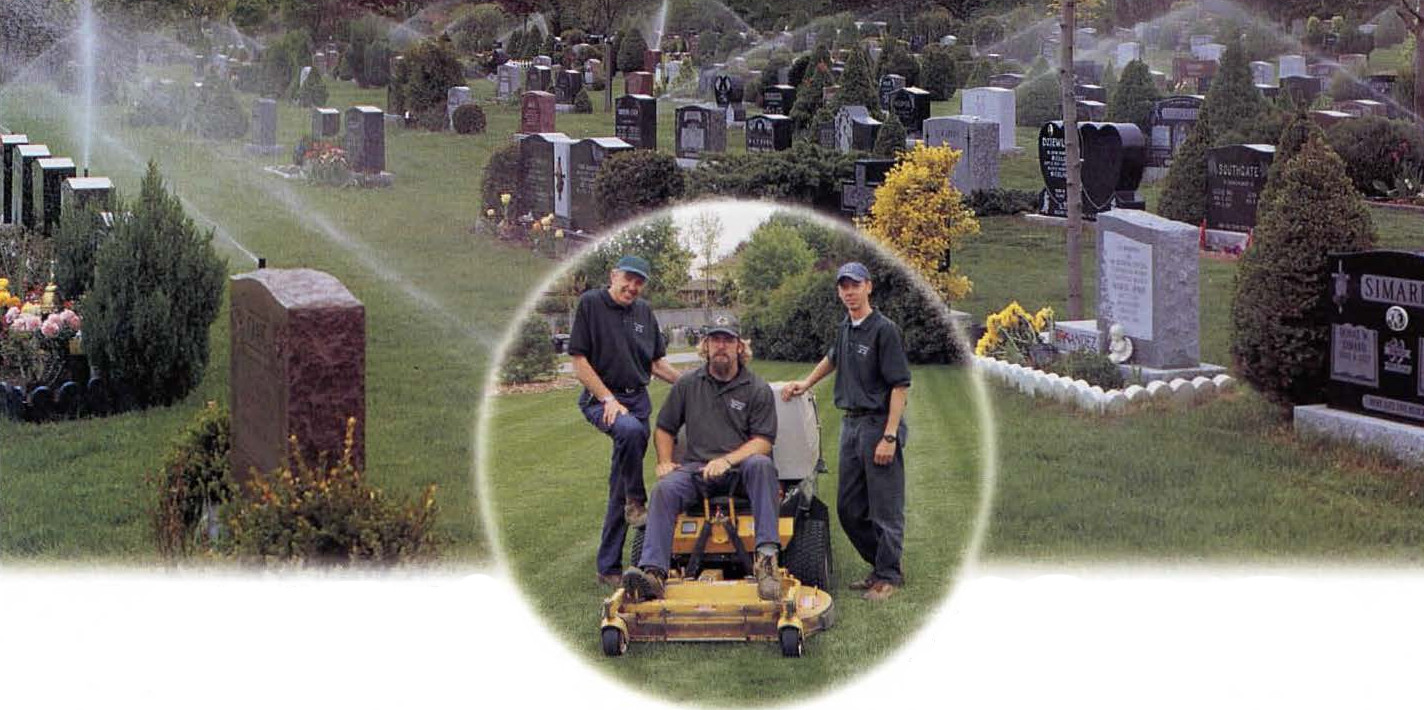Cemeteries are not often thought of as a place to test mowing equipment, unless you happen to be a member of the grounds crew that is responsible for its maintenance.
These solemn places present huge challenges for lawn maintenance professionals. Mowing between headstones is difficult, and the uneven turf is bordered by hundreds of small gardens. The proximity of these gardens and flower arrangements to the grass eliminates the use of side-discharge decks, and severely restricts the way chemicals are applied.
Springcreek Cemetery in Clarkson, Ontario, just west of Toronto, faces a few other challenges, as well. Soil there is sandy, which is good for digging but less than attractive for maintaining moisture levels. The sand is also hard on equipment. And the fact that the cemetery is old - established in 1825 - means that special care needs to be taken when mowing around the older, more fragile stones.
"That was one of the reasons we bought our first Walker," tells Bill Lawrence, superintendent and chairman of the cemetery board. "We wanted a machine that could not only handle the quantity of grass we had to mow, but do so in a gentle way."

The cemetery's two diesel Walkers work long hours mowing, applying fertilizer and spraying material, and picking up leaves and debris.
"When I first started to work here 10 years ago, it took us two weeks to complete a mowing cycle," remembers Michael Carleton, groundskeeper/mechanic. "With the Walkers, we can finish the cycle in one week."
Lawrence nods as Carleton tells his story. "I asked Michael and the others what they thought our best purchase has been. They said the John Deere Gator has been helpful with many chores, but it's second to the Walkers."
The crews use the small mulching deck 98% of the time, even in the higher-profile areas around the office and the front of the cemetery. Mulching eliminates the need to find a place to put grass clippings. It also puts nitrogen back into the soil.
The GHS decks, on the other hand, come in handy for fall cleanup, saving the cemetery the hassle and expense of hiring extra help to remove leaves. Fertilizing and spraying are also accomplished with a Walker.
Springcreek sprays once in the spring to contain crabgrass, using a Rogers Windfoil sprayer that attaches to the Walker. The sprayer keeps drift to a minimum. And its front-mount configuration gives operators the ability to easily and precisely direct the spray material.
Made for the Job
"The Walker is the only machine that can do what we need to have done," Lawrence relates. "It's also easy to work on. If one breaks down, I can usually have it up and running in less than an hour," Carleton adds. "Another thing I like about the mower is how the company is constantly striving to upgrade field machines. And the fixes can be applied to newer and older models alike."
The important thing, he emphasizes, is the big picture. It adds to the overall appearance of the cemetery. Appearance is important at any cemetery, and Springcreek happens to be in a fairly affluent area where people have especially high expectations.
The Walkers have become an integral part of this appearance, in large part because of their versatility and quality of cut. Yet, they've also made a difference in a more subdued way. Their ability to handle grass has allowed the cemetery to install a sprinkler system.
Again, Lawrence emphasizes the importance of the mulching decks, which are set at 2.5 inches in the spring and 3 inches during the summer. They deliver an excellent cut, and the clippings just disappear.
 Green Challenge
Green Challenge
Four-year Springcreek veteran Jamie Rutherford came to the cemetery with a horticultural degree. His previous landscaping experience didn't really prepare him for his new job.
"Everything we do here is a little different," he relates. "Mowers work all day long, every day. They don't get a break between jobs because there is no between jobs. They start in the morning and finish at night."
The result, he points out, is that each of the Walker Mowers accrues close to 500 hours a season just in mowing, not counting their other spring and fall chores.
“I never liked spraying with the hand sprayers," he continues. "Here, I just jump on the Walker, sit down and away you go. I don't worry about drift, and my arms don't get tired.
''And the mowing is different. Not only is it a challenge to maneuver around the headstones, but the turf is really uneven, which mandates the use of a floating deck."
The headstones are tough in other ways, adds Carleton. "Constantly rubbing the mower deck against the stones wears the side of the mower deck housing. But we solved the problem by welding a piece of steel on the side of the deck."
Then there's the sand, which not only accentuates deck and blade wear but raises havoc with air-cooled engines - Hence the diesel Walkers with Kubota watercooled engines.
The old section presents its own set of challenges. Headstones are not only fragile, but are scattered throughout the area. Lawrence emphasizes that the Walker is really the only alternative to using a walk-behind in the old section, and the best alternative in the newer section.
"This cemetery is the ultimate test for any mower. The Walkers have passed the test, to the extent that if we didn't have them, I'm afraid these guys wouldn't even be working here."
A cemetery is a landscaper's challenge. In addition to a rigorous mowing and maintenance regimen, the grounds crew at Springcreek prepares for an average of a funeral a day. They go through approximately 30 skids of sod a year. At 75 rolls per skid, that's a lot of grass. And spring time is twice as busy, with crews sodding winter graves. Even with the irrigation, new sod has to be hand-watered up to 10 days before being able to live with a normal automatic sprinkler pattern.
There are 18,000 grave sites and somewhere between 4,000 and 5,000 headstones. The cemetery grounds are busy every day with or without funerals, which serves as a constant reminder to Lawrence's crew why they work so diligently at keeping the grounds looking neat and clean.





 Site Search
Site Search



